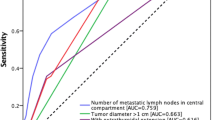Abstract
The recent prevalence of ultrasonography has made it easier to detect lymph node metastasis in the lateral compartment of patients with thyroid carcinoma. In this study, we investigated the prognostic impact of lateral node metastasis preoperatively detectable by ultrasonography (US) and metastasis diagnosed by pathology examination but not detected on preoperative US [anatomopathologically (AP)-detectable metastasis] in 560 patients with papillary carcinoma >1 cm in diameter, who underwent thyroidectomy with modified radical neck dissection at our hospital. Patients with US-detectable metastasis (US+ patients) showed a significantly worse relapse-free survival (RFS) rate than those with no metastasis (US−/AP− patients) or AP-detectable metastasis (US−/AP+ patients) regardless of tumor size. Furthermore, the RFS of US-/AP+ patients with tumors >2 cm was worse than that of US−/AP− patients with tumors >2 cm or US−/AP+ patients with tumors measuring 1.1–2.0 cm. There was no significant difference in RFS between US−/AP+ and US−/AP− patients with tumors measuring 1.1–2.0 cm. These findings suggest that US-detectable lateral metastasis predicts a worse RFS for patients regardless of tumor size, and AP-detectable metastasis affects the RFS of patients with tumors >2 cm.


Similar content being viewed by others
References
Ito Y, Tomoda C, Uruno T, et al. Preoperative ultrasonographic examination for lymph node metastasis is useful when designing lymph node dissection for papillary microcarcinoma. World J. Surg. 2004;28:498–501
Ito Y, Tomoda C, Uruno T, et al. Papillary microcarcinoma of the thyroid: how should it be treated? World J. Surg. 2004; 28: 1115–1121
Antonelli A, Miccoli P, Ferdeghini M. Role of neck ultrasonography in follow-up of patients operated on for differentiated thyroid cancer. Thyroid 1995;5:25–29
Mazzaferri EL, Young RL. Papillary thyroid carcinoma: a 10 year follow-up report of the impact of therapy in 576 patients. Am J. Med. 1994;97:418–428
Salvesen H, Njolstad PR, Akslen LA, et al. Papillary thyroid carcinoma: a multivariate analysis of prognostic factors including an evaluation of the p-TNM staging system. Eur. J. Surg. 1992;158:583–589
Akslen LA, Myking AO, Salvesen H, et al. Prognostic importance of various clinicopathological features in papillary thyroid carcinoma. Eur. J. Cancer 1992;29:44–51
Dralle H, Gimm O. Lymph node excision in thyroid carcinoma. Chirurg 1996; 67:788–806
Scheumann GF, Gimm O, Wegener G, et al. Prognostic significance and surgical management of locoregional lymph node metastases in papillary thyroidcancer. World J. Surg. 1994;18:559–567
Noguchi M, Kumaki T, Taniya T, et al. Impact of neck dissection on survival in well-differentiated thyroid cancer: a multivariate analysis of 218 cases Int. Surg. 1990;75:220–224
Bellantone R, Pio Lombardi C, Boscherini M, et al. Prognostic factors in differentiated thyroid carcinoma: a multivariate analysis of 234 consecutive patients. J. Surg. Oncol. 1998;68:237–241
Bottger T, Kupp J, Gabbert HE, et al. Prognostically relevant factors in papillary thyroid cancer. Med. Klin. 1991;86:76–82
Shaha AR, Shah JP, Loree TR. Risk group stratification and prognostic factors in papillary carcinoma of thyroid. Ann. Surg. Oncol. 1996;3:534–538
Steinmuller T, Klupp J, Rayes N, et al. Prognostic factors in patients with differentiated thyroid carcinoma. Eur. J. Surg. 2000;166:29–33
Noguchi S, Murakami N, Yamashita H, et al. Papillary thyroid carcinoma: modified radical neck dissection improves prognosis. Arch. Surg. 1998;133:276–280
Ducci M, Appetecchia M, Marzetti M. Neck dissection for surgical treatment of lymph node metastasis in papillary thyroid carcinoma. J. Exp. Clin. Cancer Res. 1997;16:333–335
Ohshima A, Yamashita H, Noguchi S, et al. Indications for bilateral modified radical neck dissection in patients with papillary carcinoma of the thyroid. Arch. Surg 2000;135:1194–1198
Author information
Authors and Affiliations
Corresponding author
Rights and permissions
About this article
Cite this article
Ito, Y., Tomoda, C., Uruno, T. et al. Ultrasonographically and Anatomopathologically Detectable Node Metastases in the Lateral Compartment as Indicators of Worse Relapse-free Survival in Patients with Papillary Thyroid Carcinoma. World J. Surg. 29, 917–920 (2005). https://doi.org/10.1007/s00268-005-7789-x
Published:
Issue Date:
DOI: https://doi.org/10.1007/s00268-005-7789-x



